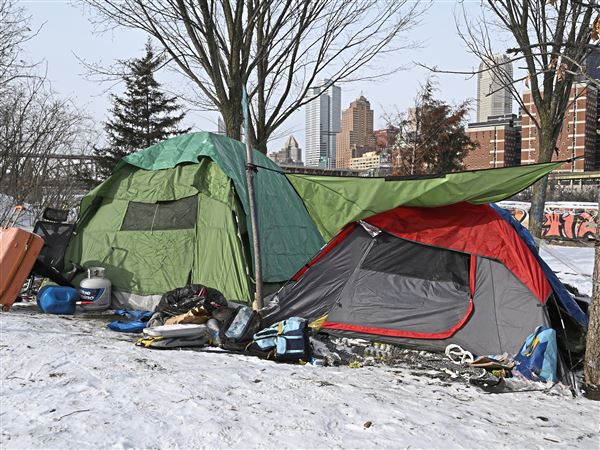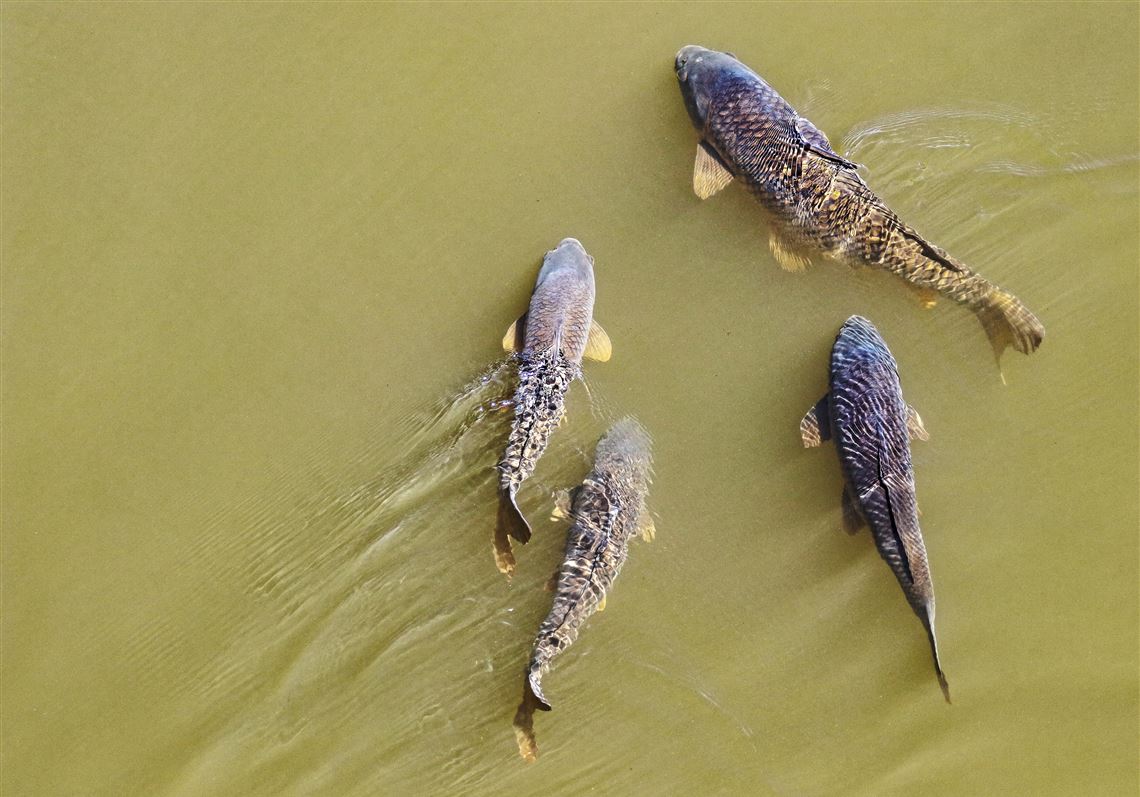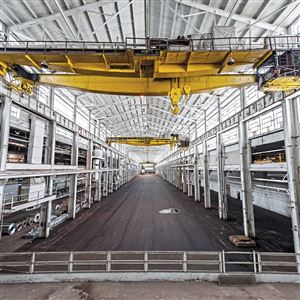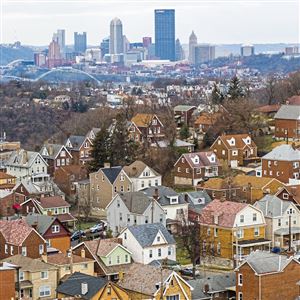This is Part 1 of two stories on the continuing impact of the closure of the Westinghouse factory on Sharon. Part 2: As Sharon tries to revive its economy, the old factory's environmental hazards lurk.
SHARON, Pa. — It was all going according to plan.
The Shenango River Watchers, a nonprofit group dedicated to reducing pollution along the river, had successfully hauled over 1.5 million pounds of trash — including refrigerators, pianos, washing machines and a prosthetic leg — out of the dirty river. The group had properly disposed of more than 55,000 tires over the past 17 years and, at last, the once filthy river was becoming cleaner by the day.
“Honestly over the last few years we’ve actually had trouble finding places to do cleanup because we don’t have the big dump sites like we used to,” Monica King, executive administrator to the Shenango River Watchers board, said. “If you go along the river, you used to see trash and you would see tires and all that sort of thing, but now you don’t see that sort of thing anymore.”
Only one problem remains: polychlorinated biphenyls.
These dangerous chemicals — PCBs for short — are leaching into the riverbed of the Shenango and are the one contaminant that the River Watchers cannot remove.
“That’s out of our wheelhouse,” Ms. King said.
A powerful carcinogen, PCBs can cause liver damage, rashes, fatigue, and headaches. The chemical can cripple the immune system and stunt cognitive development in children.
Scientists pinpointed the leak to one building along the river, a former Westinghouse plant in Sharon. In 1990, the Environmental Protection Agency added the facility to its list of Superfund Sites — the most polluted locations in the country. In 2016, Pennsylvania’s Department of Environmental Protection issued an order advising locals not to eat fish from the river.
Yet many in the area remain unaware of the advisory — and, as a result, some are eating the fish and perhaps exposing themselves to deadly health problems. The DEP and EPA decided in late June not to put up signs along the river alerting locals to the advisory after the broadcasting giant CBS — one of the companies responsible for ensuring the Westinghouse site doesn’t violate environmental regulations — did not “take on the signage,” according to an email obtained by the Post-Gazette.
■ ■ ■
For the Westinghouse site, pollution is nothing new.
From 1936 to 1976, the Westinghouse plant used PCBs in insulating oil as part of manufacturing the transformers it produced for decades. (The plant also had a brief stint manufacturing torpedoes during World War II.) When scientists discovered the chemical caused cancer in 1977, they immediately ordered Westinghouse to stop using it.
Westinghouse complied, removing and incinerating 48,000 gallons of the chemical, but the damage was done. In 1985, the EPA detected PCBs at two of the four locations where the company discharged wastewater from the plant into the Shenango. In 1988, Westinghouse found PCBs in soil and ground water in sections of the Sharon plant.
That landed the Sharon plant on the EPA’s list of Superfund sites in 1990. In 2000, the EPA ordered three companies — including current owner Winner Development, which is trying to attract tenants to the old factory — to remove 44,460 tons of soil contaminated by PCB from the site. In 2003, the EPA required them to take steps to reduce PCB leaks to the river. Initially, efforts to clean up the site seemed to work; by 2004, the EPA reported that the environmental issues had been resolved.
But new problems soon seeped to the surface. In 2015 and 2016, the EPA and Pennsylvania’s Department of Environmental Protection found “extremely high levels” of PCBs in fish samples taken from the Shenango. David P. Turner, the EPA remedial project manager for the region, wrote in a 2016 letter that the PCB levels in the Shenango were “well above” the threshold for elevated cancer risk. In smallmouth bass, for example — one of the fish locals commonly caught before the advisory — PCB levels were 22 mg/kg, more than 10 times the threshold of 1.9 mg/kg that leads state agencies to conclude the fish are unsafe to eat.
After that finding, the DEP, along with a few other state agencies, issued a “do not eat” advisory in 2016 for all fish caught in the Shenango in Mercer and Lawrence Counties. The EPA found that PCBs were flowing into the river through a storm sewer connected to the Westinghouse site. Since then, the sewer has been “partially repaired” but work to fix it completely is “still ongoing,” the EPA announced in January.
■ ■ ■
A few hundred feet down the river, for some locals, life goes on as normal.
Sharon resident Bill Meyer said he regularly sees locals swimming in the stretch of the Shenango with high PCB levels. Small amounts of PCBs can enter the body through swimming in very contaminated water.
But the most common mechanism for PCB exposure is eating contaminated fish. Because of their chemical properties, PCBs adhere to sediment that gathers at the bottom of the river. When fish eat plants from the riverbed, they ingest the PCBs — and, when humans consume contaminated fish, they do the same.
Dave Rust, who lives in Sharon, said he sees people fishing in the Shenango “almost every day” — and some of them don’t release the fish after catching them.
“They’re gonna get sick,” he said.
The reason many keep fishing, according to Mr. Meyer, is that they aren’t aware of the DEP’s advisory or the PCBs in the river. Mr. Meyer noted some of the town’s residents don’t watch the news or listen to the radio, so they could miss announcements about the advisory.
“They don’t see nothing about it,” Mr. Rust said. “How are they supposed to know?”
Darl Black, a fisherman and outdoors writer who guides fishing trips in northwest Pennsylvania, explained that many veteran, regular fishermen know about the ban. These are people who have been fishing in the same spots for years, who check online fishing message boards, and who frequently discuss fishing in the region with other avid fishermen.
Many of these fisherman have not fished in the stretch of river affected by the advisory in recent months, he said, because the Pennsylvania Fish and Boat Commission has stopped stocking that area with some species of fish, including trout and walleye.
But he said more casual fishermen likely “didn’t know about it.” He added that some people eat the fish they catch, “but not very many.”
“The ones who are eating the fish are the ones who never got the word about [the advisory],” he said. “If you don’t read the newspaper and don’t listen to the radio and don’t check your notices, yeah, you’d still be eating the fish,” he said.
Even for those who did hear about the advisory, misinformation abounds, according to some locals. Others are aware of the advisory but incorrectly think it affects Shenango Lake, said Phyllis Patterson, who works at Harry’s Lakeside Bait Shop in Sharpsville. The advisory stretches from the Shenango Dam through Mercer and Lawrence Counties, but the lake — which is north of the dam — is not included.
“People are not getting the right information,” she said.
She estimated the shop has lost 30 percent of its customers because of the incorrect perception that the advisory includes the lake.
Even among those who know where the ban starts and ends, some remain confused — or uninformed — about the EPA’s findings on the source of the PCB contamination.
Rick Como, who estimated that he fishes in Shenango Lake five days each week, said he was surprised to learn from a reporter that the EPA discovered the Westinghouse facility was the source of the PCB contamination.
“The last thing I saw is they were going to look for the source of pollution,” he said. “I haven’t seen anything about the source of the pollution or what’s being done about it.”
Brock Morocco, who also frequently fished in the Shenango, likewise said he was not aware of reports from the DEP or EPA documenting the agencies’ progress — or detailed information on the findings that led to the “do not eat” advisory in the first place.
“The problem we have is we have no information other than the specific warning they came out with,” he said. “That’s the thing that bugs everybody around here with this whole ordeal — they put out absolutely no information where [the fish] were tested, how many fish were tested.”
The DEP has spread the word about the advisory in a few ways, according to spokesperson Melanie R. Williams. The agency held a roundtable meeting at the Shenango Valley Community Library on Feb. 8 to discuss the advisory and invited local environmental groups to attend. EPA employees came to the meeting and handed out fact sheets about the Westinghouse facility clean-up. They left copies of these sheets “for the general public,” Ms. Williams wrote.
Press releases announcing the advisory are also available on the websites of the DEP, EPA, and some other state organizations.
In an email, Mr. Sternberg noted that the EPA also “mailed a fact sheet out to residents surrounding the Site and updated its webpage for the Site.”
The EPA and DEP, though, chose not to place signs along the river informing would-be fishermen of the hazards posed by the PCBs. Internal DEP and EPA emails obtained by the Post-Gazette chronicle this decision.
■ ■ ■
In posh studios in New York and Los Angeles, CBS films and produces popular TV shows. In Sharon, Pa., though, the broadcasting giant helps oversee some of the Westinghouse clean-up.
When Westinghouse bought the broadcasting company in 1995 and changed its own name to CBS, that company acquired the responsibility, in the EPA’s eyes, of overseeing the environmental risks of the Sharon Superfund site. (In 1998, the company sold Westinghouse Electric Co., the nuclear division that retains the storied name today.)
It didn’t matter that CBS employees were shooting TV promos while Westinghouse employees were welding electrical transformers for much of the 20th century. After the merger, CBS became, in EPA parlance, a “Potential Responsible Party” that would be held accountable for any environmental infractions at the site.
That’s why, when the EPA and DEP considered putting up signs, they turned to the broadcasting giant, internal emails show.
The DEP and EPA had everything lined up: they had determined that, although placing signs is an “unusual move,” “theft and vandalism” — the usual reason for forgoing signs — likely would not occur, according to a June 25, 2018, email from Thomas Barron, chief of the DEP’s Standards Section.
The agencies had determined the Pennsylvania Fish and Boat Commission would likely “assist” with posting signs “at appropriate access points” along the river, per a June 22 email sent by commission biologist Thomas Shervinskie. DEP and EPA experts had explored how to make sure the signs would be “strategically placed” along the river so that they could be “effective,” according to an August 2017 email from Mr. Barron. Employees had even sketched out a mockup of the poster.
In late June, though, their plans ground to a halt, when CBS “indicated to” the EPA “that they would not take on the signage of the Shenango River,” Charles Tordella, an environmental group manager for the DEP, wrote June 27.
In an emailed statement, however, CBS spokesperson Kelli Raftery wrote the EPA and DEP never asked CBS about signage.
“We are committed to the clean-up project for the old Westinghouse facility in the Sharon area, and we will continue to work closely and cooperatively with the leading authorities from the EPA and DEP to ensure the safety of the community and the environment,” she wrote. “We have been working with those lead agencies every step of the way, and to date, no request has been made to CBS for signage by the EPA or DEP. ”
EPA spokespeople did not respond to repeated requests for comment on CBS’s potential involvement in the decision not to put up signs. In a statement, Ms. Williams wrote the DEP and EPA decided not to put signs along the river because it is “not protocol for DEP to post signs for fish advisories.”
Some DEP and EPA employees also noted they did not think the signs would be useful.
Mr. Tordella wrote in his June 27 email that DEP water pollution biologist supervisor Joe Brancato, whom he called the “most familiar with the Shenango River in our shop,” did not “think there was a target population specifically for the signs.”
But Mr. Tordella also informed his colleagues that the DEP had “fielded several calls and letters” from locals related to the advisory, including “some comments about the lack of signs and information.”
The DEP’s conclusion: it would not pursue “the placement of streamside or access point signage, at this time,” Mr. Barron wrote June 27.
■ ■ ■
The PCBs likely won’t be removed from the river for at least a year.
The EPA has not yet formally ordered this clean-up, Mr. Sternberg wrote in an email, but the agency has communicated with CBS and the DEP. The “current plan,” he wrote, is for CBS to remove the contaminated sediment from the river in the summer of 2019. The EPA has not decided on a specific plan to clean up the river.
In the meantime, though, the pollution will likely continue to seep into the river — and some question whether the river can fully be restored to its pre-industrial state.
“There’s no saving this river,” Mr. Meyer said. “It’s gone.”
Caroline S. Engelmayer: cengelmayer@post-gazette.com or on Twitter @cengelmayer13.
First Published: July 30, 2018, 5:53 p.m.
Updated: July 30, 2018, 6:20 p.m.


















